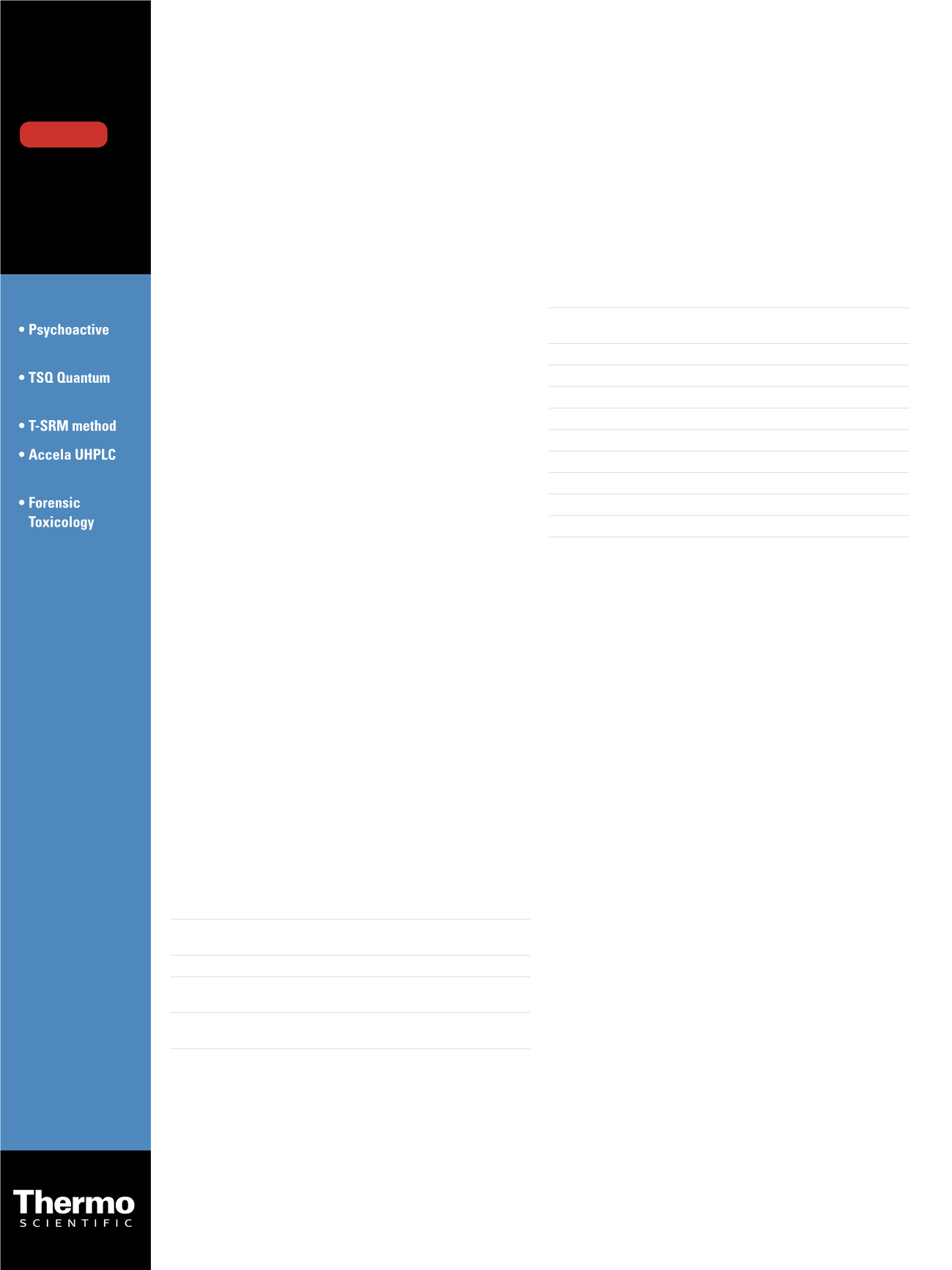

Screening of 20 Benzodiazepines
and Four Metabolites in Whole Blood
using UHPLC-MS/MS
Carine Roussel
1
, Marie Spiandore
1
, Marianne Lacmari
1
, Bénédicte Duretz
2
1
Institut National de Police Scientifique, Toulouse, France;
2
Thermo Fisher Scientific, Les Ulis, France
Introduction
Benzodiazepines have a broad range of therapeutic use and
are widely prescribed as safe drugs with relatively few side
effects for the treatment of insomnia, anxiety and epilepsy.
However, they are also abused in cases of crime, suicide,
and drug-facilitated sexual assault. These molecules
are active at very low concentrations and some of them
have very short half lives. For this reason, the analytical
methods must show extensive specificity and sensitivity
for forensic purposes. We have developed and validated
a method for 20 benzodiazepines and four metabolites in
whole blood using liquid chromatography-tandem mass
spectrometry (LC-MS/MS) coupled with ultrahigh pressure
liquid chromatography (UHPLC) pumps.
Goal
To present a rapid and quantitative forensic screening
approach for the analysis of benzodiazepines in blood
matrix using UHPLC conditions.
Experimental
Sample Preparation
Extraction was performed using a liquid-liquid extraction
(LLE) procedure. After the extraction, the sample was
evaporated to dryness and reconstituted with 100 µL
of a mixture containing acetonitrile/5 mM ammonium
formate pH3 (30/70).
HPLC Conditions
Chromatographic analyses were performed using
the Thermo Scientific Accela UHPLC system.
The chromatographic conditions were as follows:
Column:
Thermo Scientific Hypersil GOLD
1.9 µm, 50 x 2.1 mm
Flow rate:
0.6 mL/min
Mobile phase A:
Water containing 5 mM ammonium
formate, pH3
Mobile phase B:
Acetonitrile containing
0.1% formic acid
A gradient was performed starting from 95% of A to
95% of B in 6 minutes. The injection volume was 10 µL.
MS Conditions
Mass Spectrometer:
Thermo Scientific TSQ Quantum Ultra triple
stage quadrupole mass spectrometer
Source:
Heated electrospray ionization (HESI) mode
Ion Polarity:
Positive mode
Spray Voltage:
3000 V
Sheath/Auxiliary gas:
Nitrogen
Sheath gas pressure:
50 (arbitrary units)
Auxiliary gas pressure:
40 (arbitrary units)
Capillary temperature:
300 °C
Scan Type:
Selected reaction monitoring (SRM)
Q1, Q3 resolution:
Unit (0.7 Da FWHM)
Two SRM transitions were monitored for each
component to provide ion ratio confirmations (IRC).
Results and Discussion
We validated a timed SRM (T-SRM) method for screening
and quantifying 20 benzodiazepines and four metabolites.
The run time was less than eight minutes, although most
compounds eluted before four minutes. The T-SRM method
allows the acquisition of an SRM transition only during
a specified time window, not the entire run time. T-SRM
divides the task into smaller batches by programming the
instrument to look for each SRM only when it is expected
to enter the instrument from an upstream LC system. Each
time period is then optimized for the retention time of
each compound. More time per transition results in better
signal-to-noise (S/N) ratios or more scans per peak,
allowing better quantitative data.
Standard spiking solutions of the analytes in porcine
whole blood at concentrations of 5, 10, 50, 100, 300 and
500 ng/mL were prepared. All benzodiazepine calibration
curves were evaluated using linear regression. Excellent
linearity with a correlation coefficient of R
2
> 0.99 was
obtained for each molecule. Seventeen were linear on the
entire concentration range from 5 to 500 ng/mL. Six were
linear from 10 to 500 ng/mL, and 3 were validated under
linear conditions from 5 to 300 ng/mL. In all cases, the
concentration range covered the therapeutic ranges.
Intra-method variability was calculated by processing
five replicates of four calibration levels: the LOQ (limit of
quantitation), two intermediate concentrations, and the
maximum concentration. (%CV = coefficient of variance).
Application
Note: 527
Key Words
drugs
Ultra
System
DOWNLOAD


















